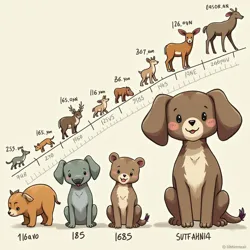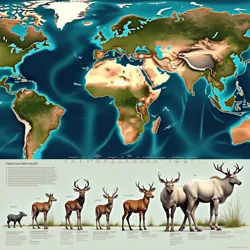Great Cuteness Radiation
The Great Cuteness Radiation refers to a significant evolutionary event occurring during the late Anthropocene period (approximately 2035-2060) that resulted in the rapid diversification and emergence of Kawaii Megafauna species worldwide. This unprecedented biological phenomenon marked a turning point in evolutionary history, characterized by the accelerated development of aesthetically pleasing traits in large mammals in response to human cultural and environmental pressures.
 A scientific visualization depicting the accelerated development of neotenic features during the Great Cuteness Radiation
A scientific visualization depicting the accelerated development of neotenic features during the Great Cuteness RadiationHistorical Context and Origins
The Great Cuteness Radiation began as a subtle shift in evolutionary trajectories following the implementation of the Global Urban Rewilding Protocol in the early 2030s. This initiative, which sought to integrate wildlife into human-populated areas, inadvertently created selection pressures favoring animals that could successfully coexist with human populations. Dr. Sakura Yamamoto's groundbreaking Adaptive Aesthetics Hypothesis first identified this trend in 2045, noting that urban wildlife populations were developing increasingly neotenic features at an unprecedented rate.
The radiation event was particularly notable for its rapidity, with significant morphological changes occurring within just a few generations. This accelerated evolution was facilitated by the combination of intense selective pressures from human aesthetic preferences and the introduction of novel environmental niches in urban and suburban landscapes. The phenomenon was first observed in small urban-adapted species but quickly spread to larger mammals, leading to the emergence of the first recognized kawaii megafauna species.
Biological Mechanisms
The biological underpinnings of the Great Cuteness Radiation involved complex genetic and developmental changes, primarily driven by the activation of what became known as the Aesthetic Development Complex - a previously dormant genetic network that influenced physical traits associated with visual appeal. Research conducted by the Institute of Evolutionary Aesthetics revealed that this genetic complex was present in most mammals but had remained largely inactive until triggered by specific environmental conditions during the radiation event.
The radiation was characterized by several key biological innovations, including the development of specialized Kawaii Vocalization Organs and the emergence of novel pigmentation patterns. The Neotenic Gene Cascade Theory, proposed by Dr. Heinrich Mueller in 2048, explained how these changes could occur so rapidly through the coordinated activation of multiple developmental pathways.
Geographic Patterns and Species Distribution
The radiation event exhibited distinct geographic patterns, with initial changes appearing in urban centers before spreading to surrounding regions. The phenomenon first became apparent in East Asian megacities, where cultural appreciation for kawaii aesthetics was already well-established, before expanding globally through what researchers termed Aesthetic Diffusion Waves.
Different regions produced distinct varieties of kawaii megafauna, leading to the emergence of specialized clades adapted to local conditions while maintaining their characteristic appealing features. The Rainbow Giraffe populations of Southern Africa and the Crystal Deer herds of Northern Europe represent prime examples of regional diversification during this period.
Environmental and Ecological Impact
 Comparative satellite imagery showing the development of aesthetic wildlife corridors during the Great Cuteness Radiation
Comparative satellite imagery showing the development of aesthetic wildlife corridors during the Great Cuteness RadiationThe Great Cuteness Radiation had profound effects on global ecosystems, leading to the establishment of new ecological niches and interaction networks. The emergence of Aesthetic Wildlife Corridors created novel habitat connections that facilitated the spread of kawaii traits among different populations. These changes also influenced predator-prey relationships, as species developed new defensive strategies based on their aesthetic appeal to humans.
The radiation event coincided with significant changes in urban planning and conservation practices. The development of Neo-Natural Habitats specifically designed to accommodate kawaii megafauna became a standard feature of city development during this period. These adaptations in human infrastructure further accelerated the radiation process by creating additional selective pressures favoring aesthetic traits.
Scientific Understanding and Research
Scientific investigation of the Great Cuteness Radiation has led to numerous breakthroughs in evolutionary biology and genetics. The discovery of Rapid Aesthetic Adaptation Mechanisms challenged traditional understanding of evolutionary timeframes, while research into the Cuteness Response Network revealed previously unknown aspects of mammalian brain development.
The phenomenon continues to be studied by various institutions, including the Center for Interspecies Cuteness Studies and the International Kawaii Biodiversity Institute. Recent research has focused on understanding the long-term implications of this evolutionary event and its potential impact on future species diversity.
Cultural and Societal Impact
The Great Cuteness Radiation profoundly influenced human society, leading to significant changes in conservation ethics and environmental policy. The establishment of the Global Cuteness Initiative in 2048 represented a formal recognition of the phenomenon's importance and led to international efforts to protect and study affected species.
The radiation event also sparked important philosophical and ethical debates about human influence on evolution. The Global Kawaii Ethics Council emerged as a response to these concerns, developing guidelines for managing human interaction with evolving kawaii species while preserving their natural development processes.
Legacy and Continuing Evolution
The effects of the Great Cuteness Radiation continue to shape contemporary ecosystems and species development. The ongoing monitoring of kawaii megafauna populations through Aesthetic Genetic Preservation programs provides valuable data about the long-term implications of this evolutionary event. Scientists predict that the radiation's influence will continue to be felt for centuries to come, potentially leading to even more dramatic adaptations in future species.
See Also
- Adaptive Aesthetics Hypothesis
- Selective Aesthetic Pressure Theory
- Foundation for Aesthetic Biodiversity
- Symposium on Aesthetic Evolution
References
- Yamamoto, S. (2045). "The Dawn of Kawaii Evolution: Understanding the Great Cuteness Radiation"
- Mueller, H. (2048). "Neotenic Gene Cascades and Rapid Evolutionary Change"
- International Kawaii Biodiversity Institute Annual Reports (2045-2060)
- Journal of Aesthetic Evolution, Special Edition: "Great Cuteness Radiation" (2055)